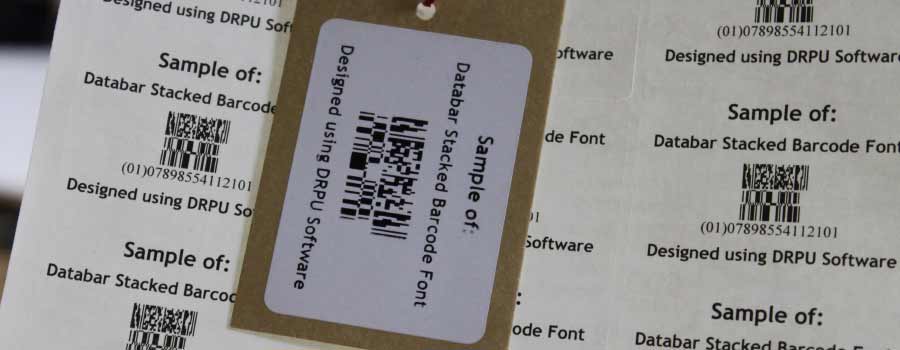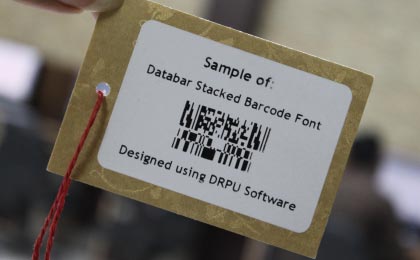-
Benefits of Databar Stacked
Barcode
Databar Stacked has several benefits for both retailers and consumers. For retailers, it provides a more efficient way to manage inventory and pricing information. By encoding information such as weight, price, and expiration date, retailers can easily track inventory levels and ensure that products are priced correctly. This can help reduce errors and save time compared to manually entering this information into a computer system.
Databar Stacked also provides benefits for consumers. By encoding information such as expiration date, consumers can easily identify products that are close to their expiration date and make informed purchasing decisions. This can help reduce waste and ensure that consumers are purchasing fresh products.
-
Features of Databar Stacked Barcode
Databar Stacked is a two-dimensional barcode that is made up of stacked rows of bars. It is similar to the original DataBar symbology but has the ability to encode more information in a smaller space. DataBar Stacked can encode up to 14 digits of a GTIN (Global Trade Item Number) along with additional product information such as weight, price, and expiration date. It also includes a check digit that is used to ensure the barcode is read correctly.
Databar Stacked is designed to be easily read by both handheld and stationary scanners. It can be printed on a variety of surfaces including paper, plastic, and cardboard. The size of the barcode can be adjusted to fit the size of the product packaging.
-
Uses of DataBar Stacked
Barcode
Databar Stacked is widely used in the retail industry, particularly in grocery stores and other food retailers. It is used to encode information such as weight, price, and expiration date on a variety of products including fresh produce, meat, and dairy products. DataBar Stacked is also used to encode information on products such as pharmaceuticals, where accurate tracking of expiration dates is critical.
Databar Stacked is also used in the healthcare industry to track medical products such as vaccines and blood products. By encoding information such as the lot number and expiration date, healthcare providers can easily track the use of these products and ensure that they are used before they expire.
In Conclusion, Databar Stacked is a two-dimensional barcode that is widely used in the retail and healthcare industries. It is designed to provide additional information about a product in a small amount of space, including information such as weight, price, and expiration date. DataBar Stacked provides several benefits for both retailers and consumers, including more efficient inventory management and informed purchasing decisions.
Databar Stacked Barcode is Different form Other Barcode Types
Databar Stacked is a type of barcode that is different from other barcode types in several ways. In this article, we will explain how DataBar Stacked differs from other barcode types in terms of its structure, capacity, and use cases.

-
Structure:
Databar Stacked is a two-dimensional barcode that is composed of stacked rows of bars. The bars are arranged in a vertical manner and can be read by both handheld and stationary scanners. Unlike linear barcodes, DataBar Stacked can encode more information in a smaller amount of space, making it a popular choice for retailers who need to encode product information in limited space on their packaging.
Other barcode types, such as UPC and EAN, are linear barcodes that are made up of a series of parallel bars and spaces. They are read by scanning the bars in a horizontal manner. While these barcodes are capable of encoding a significant amount of information, they are not as space-efficient as DataBar Stacked.
-
Capacity:
Databar Stacked has a higher capacity than linear barcodes, meaning it can encode more information in a smaller amount of space. DataBar Stacked can encode up to 14 digits of a GTIN (Global Trade Item Number) along with additional product information such as weight, price, and expiration date. This makes it ideal for encoding product information on small items such as pharmaceuticals, where space is limited.
In contrast, linear barcodes such as UPC and EAN are limited in their capacity. UPC barcodes can encode up to 12 digits, while EAN barcodes can encode up to 13 digits. While these barcodes can encode additional information, such as weight and price, they require additional characters and space.
-
Use Cases:
Databar Stacked is primarily used in the retail industry to encode product information such as weight, price, and expiration date on small items such as fresh produce, meat, and dairy products. It is also used to encode information on pharmaceuticals and other medical products, where accurate tracking of expiration dates is critical.
Linear barcodes such as UPC and EAN are widely used in the retail industry to encode product information on a variety of items such as consumer goods, books, and magazines. They are also used in logistics and supply chain management to track products from the manufacturer to the consumer.
In Conclusion, trusted Databar Stacked differs from other barcode types in terms of its structure, capacity, and use cases. Its stacked row structure allows it to encode more information in a smaller amount of space, making it ideal for small items such as pharmaceuticals and fresh produce. Its high capacity and accuracy make it an important tool for tracking product information and ensuring product safety in the retail and healthcare industries. While other barcode types such as UPC and EAN are also widely used, DataBar Stacked offers a unique set of features and benefits that make it a popular choice for retailers and manufacturers.
Databar Stacked is a Barcode for Encoding Information
Databar Stacked is a two-dimensional barcode that is capable of encoding a significant amount of information in a small amount of space. The barcode is composed of stacked rows of bars, and can encode up to 14 digits of a GTIN (Global Trade Item Number) along with additional product information such as weight, price, and expiration date. In this article, we will explain the different types of information that can be encoded in a DataBar Stacked barcode.
-
GTIN - Global Trade Item Number
A GTIN is a unique number that is assigned to each product by the manufacturer. The number is used to identify the product and track it throughout the supply chain. DataBar Stacked can encode up to 14 digits of a GTIN, making it a powerful tool for tracking products and ensuring their safety.
-
Weight
DataBar Stacked can also encode information about the weight of a product. This is particularly useful for products that are sold by weight, such as fresh produce or meat. The weight information can be used to calculate the price of the product and ensure that the correct amount is charged to the customer.
-
Price
DataBar Stacked can encode information about the price of a product. This allows retailers to easily scan the barcode and automatically calculate the price of the product. This information can also be used to ensure that the correct price is charged to the customer, reducing the likelihood of errors and disputes.
-
Expiration Date
DataBar Stacked can also encode information about the expiration date of a product. This is particularly useful for products that have a limited shelf life, such as pharmaceuticals and food products. The expiration date information can be used to ensure that the product is removed from the shelves before it becomes unsafe to consume.
-
Serial Number
DataBar Stacked can also encode a serial number, which is a unique identifier that is assigned to each individual product. This allows manufacturers and retailers to track each product throughout the supply chain, making it easier to identify and address any issues that may arise.
-
Batch Number
DataBar Stacked can also encode a batch number, which is a unique identifier that is assigned to a group of products that are manufactured together. This allows manufacturers to track the production process and identify any issues that may arise with a particular batch of products.
-
Country of Origin
DataBar Stacked can also encode information about the country of origin of a product. This is particularly important for products that are subject to import/export regulations or for customers who prefer to buy products that are made in a particular country.
-
Manufacturer Information
DataBar Stacked can also encode information about the manufacturer of a product, including their name, address, and contact information. This allows retailers and customers to easily identify the manufacturer of the product and contact them if necessary.
In Conclusion, Databar Stacked is a powerful barcode that is capable of encoding a wide range of product information. From GTINs and weight to price, expiration dates, serial numbers, and manufacturer information, DataBar Stacked is a versatile tool for tracking and identifying products throughout the supply chain. By encoding this information in a small and easily scannable barcode, manufacturers and retailers can ensure that products are tracked accurately and efficiently, reducing the likelihood of errors and increasing customer satisfaction.
Download and Install Barcode Software
Databar Stacked Barcode: Read & Decode
A Databar Stacked barcode, also known as a GS1 DataBar Stacked Omnidirectional barcode, is a two-dimensional barcode used for encoding information about products and inventory. This type of barcode is commonly used in the retail industry for small items such as fresh produce, meat, and baked goods.
DataBar Stacked barcodes are designed to be read by a barcode scanner, which uses a laser or camera to scan the barcode and decode the information contained within it. In this article, we will discuss the process of reading and decoding a DataBar Stacked barcode.

-
Scanning the Barcode
The first step in reading a DataBar Stacked barcode is to scan the barcode using a barcode scanner. The scanner emits a laser beam or takes a picture of the barcode, and then the device processes the data contained within the barcode. There are several types of barcode scanners available on the market, including handheld scanners, fixed-mount scanners, and mobile device cameras.
-
Decoding the Barcode
Once the barcode has been scanned, the barcode scanner begins the process of decoding the information contained within the barcode. The scanner uses software to analyze the pattern of black and white bars in the barcode and convert it into a digital code that can be understood by a computer.
-
Reading the Barcode Data
The information contained within a DataBar Stacked barcode is organized into several different fields, each of which contains a specific piece of data about the product. The fields are separated by specific characters, which are used by the barcode scanner to identify the beginning, end of each field.
-
Interpreting the Barcode Data
After the data has been read, it must be interpreted by a computer system to determine what information it represents. This is typically done using software that is designed to recognize the specific format of the DataBar Stacked barcode and extract the relevant information from it.
-
Using the Barcode Data
Once the data has been interpreted, it can be used for a variety of different purposes, such as inventory management, product tracking, and pricing. The data can also be used to automate certain processes, such as ordering new inventory when stock levels reach a certain threshold.
In summary, reading and decoding a DataBar Stacked barcode involves scanning the barcode using a barcode scanner, decoding the information contained within the barcode, reading the barcode data, interpreting the barcode data, and using the barcode data for a variety of different purposes. While the process may seem complex, modern barcode scanning technology has made it fast and easy to read and decode barcodes in a variety of different settings.
